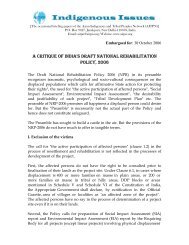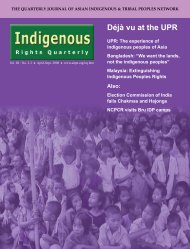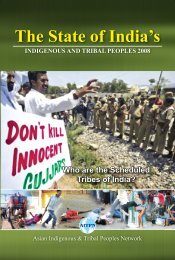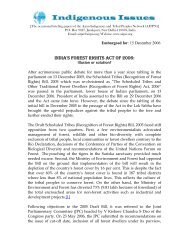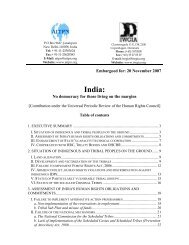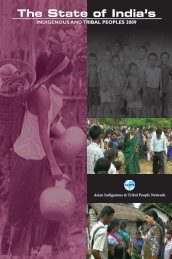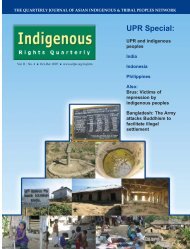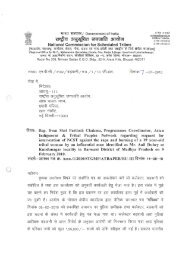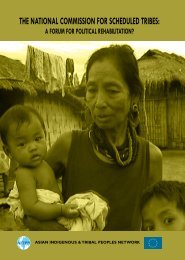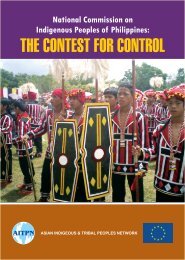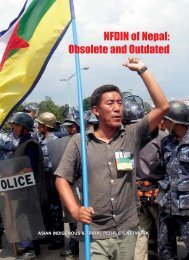the orissa rehabilitation & resettlement policy, 2006 - Asian ...
the orissa rehabilitation & resettlement policy, 2006 - Asian ...
the orissa rehabilitation & resettlement policy, 2006 - Asian ...
You also want an ePaper? Increase the reach of your titles
YUMPU automatically turns print PDFs into web optimized ePapers that Google loves.
[The occasional briefing papers of <strong>the</strong> <strong>Asian</strong> Indigenous and Tribal Peoples Network (AITPN)]<br />
P.O. Box 9627, Janakpuri, New Delhi-110058, India<br />
Email: aitpn@aitpn.org; Website: www.aitpn.org<br />
Embargoed for: 8 September <strong>2006</strong><br />
THE ORISSA REHABILITATION & RESETTLEMENT POLICY, <strong>2006</strong>:<br />
AN INSTRUMENT OF FURTHER DISPLACEMENT<br />
Following <strong>the</strong> adoption of <strong>the</strong> Orissa Rehabilitation and Resettlement Policy <strong>2006</strong><br />
(ORRP) in May <strong>2006</strong>, according to The Statesman of 4 September <strong>2006</strong>, <strong>the</strong> Tata<br />
Steel reportedly provided jobs to 29 displaced from Kalinga Nagar. The beneficiaries<br />
were reportedly trained in welding technology by <strong>the</strong> steel company. In May <strong>2006</strong>,<br />
<strong>the</strong> State government of Orissa promulgated <strong>the</strong> Orissa Rehabilitation and<br />
Resettlement Policy (ORRP) following <strong>the</strong> Kalinganagar Massacre in which 14 tribals<br />
were shot dead.<br />
There has been little comment on <strong>the</strong> ORRP, possibly because battelines remained<br />
drawn in Kalinganagar where <strong>the</strong> Adivasis continue to maintain <strong>the</strong> barricade. Yet,<br />
<strong>the</strong> ORRP will be utilized by <strong>the</strong> State government of Orissa for <strong>rehabilitation</strong> of <strong>the</strong><br />
displaced.<br />
AITPN analyses <strong>the</strong> ORRP which fails to meet <strong>the</strong> basic standards.<br />
The ORRP <strong>2006</strong> identified displacement by six types of projects: Industrial Projects;<br />
Mining Projects; Irrigation Projects, National Parks and Sanctuaries; Urban and<br />
Linear Projects; and any o<strong>the</strong>r projects. The ORRP provides for employment to an<br />
eligible member from each displaced family in cases of displacement by Industrial<br />
and Mining projects. For Industrial Projects and Mining Projects, it provides one time<br />
cash assistance upto maximum of Rs 5 lakhs for displaced families who have lost all<br />
land including homestead land. Provision for granting of free homestead land of<br />
1/10th acre in <strong>the</strong> <strong>resettlement</strong> habitat to each displaced family “subject to<br />
availability” of land has been envisaged. If land is not available, it provides for<br />
compensation of Rs 50,000. The ORPP also provides for house building assistance of<br />
Rs 1.5 lakh for each displaced family and a monthly maintenance allowance of Rs<br />
2,000 to each displaced family for a period of one year.<br />
The Orissa Rehabilitation and Resettlement Policy <strong>2006</strong> cannot address <strong>the</strong> root<br />
causes of <strong>the</strong> dispossession of <strong>the</strong> Adivasis in <strong>the</strong> state.<br />
First, <strong>the</strong> Orissa Rehabilitation and Resettlement Policy <strong>2006</strong> failed to address <strong>the</strong> fact<br />
that State government has been acting as broker and profiting from <strong>the</strong> lands of <strong>the</strong><br />
peoples by exercising its sovereign power. In 2004, <strong>the</strong> state government had sold
THE ORISSA REHABILITATION & RESETTLEMENT POLICY, <strong>2006</strong>:<br />
AN INSTRUMENT OF FURTHER DISPLACEMENT<br />
2<br />
2,000 acres of land to <strong>the</strong> Tatas for Rs 3.35 lakh per acre. The state government paid<br />
only Rs 76,000 an acre to <strong>the</strong> original landowners given <strong>the</strong> fact that even <strong>the</strong> current<br />
market rate for an acre was Rs 5 lakh. Besides, <strong>the</strong> Rs 76,000 was meant only for<br />
titleholders, who account for 20 per cent of <strong>the</strong> tribals in <strong>the</strong> area. The promise of a<br />
job for each displaced family, a home allowance of Rs 50,000 and Rs 5,000 as aid for<br />
a temporary shelter were never adequately fulfilled. 1<br />
Second, <strong>the</strong> Orissa Rehabilitation and Resettlement Policy <strong>2006</strong> contained serious<br />
shortcomings which only legalised past illegal practices – <strong>the</strong> arbitrary exercise of <strong>the</strong><br />
sovereign power of <strong>the</strong> State for <strong>the</strong> benefit of <strong>the</strong> private companies:<br />
The Orissa Rehabilitation and Resettlement Policy (ORRP) <strong>2006</strong> is meant only for<br />
prospective displaced families. Clause 5(a) to (c) of <strong>the</strong> <strong>policy</strong> only refers to<br />
undertaking socio-economic survey for identification of displaced families and<br />
preparing <strong>the</strong>ir socio-economic base line, approving of <strong>the</strong> said list of displaced<br />
families by <strong>the</strong> respective Rehabilitation and Periphery Development Advisory<br />
Committee (RPDAC) and displaying of <strong>the</strong> approved list at public places like<br />
Collectorate/Block/Tehsil/ Panchayat for wider information;<br />
The ORRP <strong>2006</strong> is meant only for families who would be displaced in future and<br />
states nothing about <strong>the</strong> 1.4 million already displaced people, mostly indigenous<br />
peoples. Clause 5(a) of <strong>the</strong> Policy categorically states, “Ordinarily within two months<br />
of publication of notice for acquisition of land for <strong>the</strong> development project, a socioeconomic<br />
survey would be undertaken in <strong>the</strong> manner to be decided by <strong>the</strong><br />
Government for identification of displaced families and for preparing <strong>the</strong>ir socioeconomic<br />
baseline”.<br />
The ORRP <strong>2006</strong> does not provide for free, prior and informed consent of <strong>the</strong> affected<br />
families before acquisition of <strong>the</strong> land. Clause 7 of <strong>the</strong> Policy only refers to<br />
“Procedure prescribed by <strong>the</strong> government” in acquisition of land and o<strong>the</strong>r properties<br />
without specifying <strong>the</strong> socalled “procedure prescribed by <strong>the</strong> government”;<br />
There is no mandatory provision for land as <strong>rehabilitation</strong> benefit. Only in case of<br />
displacement by Irrigation Projects, National Parks and Sanctuaries (Type C),<br />
assistance for agricultural land has been provided for. Since <strong>the</strong> majority of <strong>the</strong><br />
displaced comprised of indigenous and tribal peoples whose primary occupations are<br />
agriculture and forest related activities, <strong>the</strong>ir livelihood would be adversely affected in<br />
<strong>the</strong> absence of mandatory provision for land as a <strong>rehabilitation</strong> benefit. This violates<br />
provisions of <strong>the</strong> 5th Schedule of <strong>the</strong> Constitution of India which guarantees <strong>the</strong> rights<br />
1 . Displaced on road with dead, The Telegraph, Kolkata, 4 January <strong>2006</strong><br />
Indigenous Issues – The Occasional Briefing Papers of AITPN
THE ORISSA REHABILITATION & RESETTLEMENT POLICY, <strong>2006</strong>:<br />
AN INSTRUMENT OF FURTHER DISPLACEMENT<br />
3<br />
of <strong>the</strong> tribals over <strong>the</strong>ir land and prohibits transfer of tribal lands to non-tribals. In<br />
historic Samata Judgment of July 1997, <strong>the</strong> Supreme Court of India held that all <strong>the</strong><br />
lands leased to private companies by <strong>the</strong> government of Andhra Pradesh are<br />
unconstitutional, and hence null and void.<br />
In case of displacement by Urban and Linear Projects as provided in Clause 9 (iv) (c),<br />
“…….<strong>the</strong> project authority shall provide employment to one of <strong>the</strong> members of such<br />
displaced family in <strong>the</strong> project.” Urban and Linear projects are usually periodic and<br />
one-time in nature contrary to industries. Therefore, employment in such projects is<br />
expected to be temporary.<br />
In Clause 10 (a) & (b), <strong>the</strong> Policy provides for ex-gratia compensation up to a<br />
maximum of one standard acre “if <strong>the</strong> encroachment is unobjectionable”. But<br />
nowhere in <strong>the</strong> <strong>policy</strong> has <strong>the</strong> word “unobjectionable” been defined. There is every<br />
likelihood that <strong>the</strong> government will misuse this clause to effectively deprive any<br />
compensation whatsoever.<br />
The ORRP still uses derogatory terms such as “primitive tribal groups” in Clause 13.<br />
In Clause 17, <strong>the</strong> Policy does not make it mandatory to include representatives of <strong>the</strong><br />
displaced families and NGOs in <strong>the</strong> Rehabilitation and Periphery Development<br />
Advisory Committee (RPDAC). The wordings “…it (<strong>the</strong> government) may<br />
include….” suggest that <strong>the</strong> government may or may not include <strong>the</strong> displaced<br />
peoples’ representatives and NGOs;<br />
In Clause 21, <strong>the</strong> Policy provides that “effective participation of <strong>the</strong> displaced<br />
communities will be ensured in <strong>the</strong> process.” But <strong>the</strong>re is no clearly defined<br />
mechanism for ensuring such “effective participation” of <strong>the</strong> aggrieved people.<br />
The Policy does not guarantee homestead land to all <strong>the</strong> displaced families in<br />
<strong>resettlement</strong> habitat. “Provision for homestead land” states - “Subject to availability,<br />
each displaced family will be given at least 1/10th of land free of cost in a<br />
<strong>resettlement</strong> habitat for homestead purpose”. As per <strong>the</strong> provision, a displaced family<br />
shall be given one time cash grant of Rs 50,000 in lieu of homestead land.<br />
The ORRP does not address <strong>the</strong> rights of <strong>the</strong> displaced but will certainly be used as an<br />
instrument for fur<strong>the</strong>r displacement.<br />
Indigenous Issues – The Occasional Briefing Papers of AITPN



